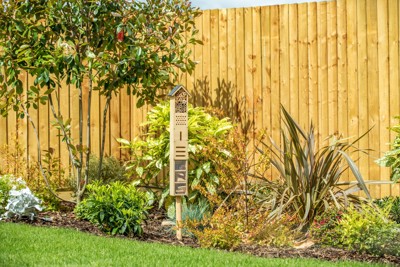At Cala, we’ve been coming up with ways to help protect and enhance wildlife and plant life in and around our neighbourhoods. Recognising the importance of the climate emergency and the vital role that maintaining and enhancing biodiversity and habitats plays as part of an integrated response, Cala’s Thames Land and Planning team have recently launched their Urban Wildlife Strategy. We are busy working on a plan for supporting biodiversity as part of our wider Sustainability Strategy to roll out across the rest of the Group.
But in the meantime, we have some top tips for encouraging flora and fauna in your own garden…
Our top ways to help wildlife and plant life flourish in your garden
Create habitats for minibeasts to enjoy
 Bird boxes, bat boxes and solitary bee boxes can be easily installed in your garden to help provide shelter for these important minibeasts. Wildlife boxes and bug hotels can also be really fun to make. There are lots of online resources to help you decide on the best options for your garden and the species you’ll find there. Take a look at our Urban Wildlife Strategy, a first for Cala Group devised by our Thames region, which creates a design framework that establishes a biodiversity standard for every new home.
Bird boxes, bat boxes and solitary bee boxes can be easily installed in your garden to help provide shelter for these important minibeasts. Wildlife boxes and bug hotels can also be really fun to make. There are lots of online resources to help you decide on the best options for your garden and the species you’ll find there. Take a look at our Urban Wildlife Strategy, a first for Cala Group devised by our Thames region, which creates a design framework that establishes a biodiversity standard for every new home.

Make your garden a wildlife haven
Creating cosy, safe places for wildlife to shelter, nest and breed is a fantastic way to use your garden. Shrubs and wood piles can offer the perfect home for nature in your garden – a staggering number of minibeasts, fungi and some plants rely on dead or rotting wood for food, shelter, a place to nest or to grow on.

Bring some bloom with a wildflower area
Try finding somewhere in your garden to plant grassland with lots of native flowers – bees and other pollinators will thank you for it! You can sow a meadow seed mix, lay ready grown flower-rich turf or even sow wildflowers in a large planter. September is a good time to do this to make sure dandelions are ready to provide nectar for busy bees come early spring.
Water good idea
Consider introducing a water feature to your garden, such as a bird bath. In the winter, it could be the only source of water for thirsty birds, and it can also add a lovely visual feature to your space.
Something to pond-er
Ponds are veritable playgrounds for all sorts of wildlife and a brilliant addition to encourage biodiversity. They provide habitats for a huge variety of animals, which will come to breed, feed, bathe and drink. Ponds can be either formal or informal (more natural) and can vary in size depending on space, safety or the time and effort you want to put in. Make your pond interesting for wildlife with boulders, large pebbles, gravel, ‘beaches’, and even aquatic compost. Please make sure you follow pond safety measures and ensure children are always supervised.

Food for thought
Selecting flowers and plants for your garden that are rich in pollen and nectar is a great way to support flora and fauna. Using a rich mix of native species is a good way to ensure plant life can withstand the British weather and attracts a range of wildlife. Try to include a variety of colour, shapes, sizes and fragrances that will flower and fruit at different times.
Support local
Why not research the flora, fruits and veggies native to your area, and plant a variety in your garden, or a hanging garden if you have an apartment? Local nurseries or garden centres can be great sources of information about plant maintenance and care.
Get composting
Compost is great for making healthy, nutrient-rich soil, perfect for plants and wildlife. Make your own compost with your garden waste to naturally recycle nutrients. The organic matter also provides shelter for creatures, which make the most of the heat emitted by decomposition.

Win, win with water
Water butts, when attached to the downpipe from a roof (including sheds), collect run- off water and reduce mains water usage. The surplus water can be directed into other garden features such as rain gardens and ponds – win, win!
Inspire the future
Inspiring future generations to love and respect wildlife and learn about our ecosystems is a great way to protect nature in the long-term. Try out our wildlife activity pack and have some fun whilst learning.






